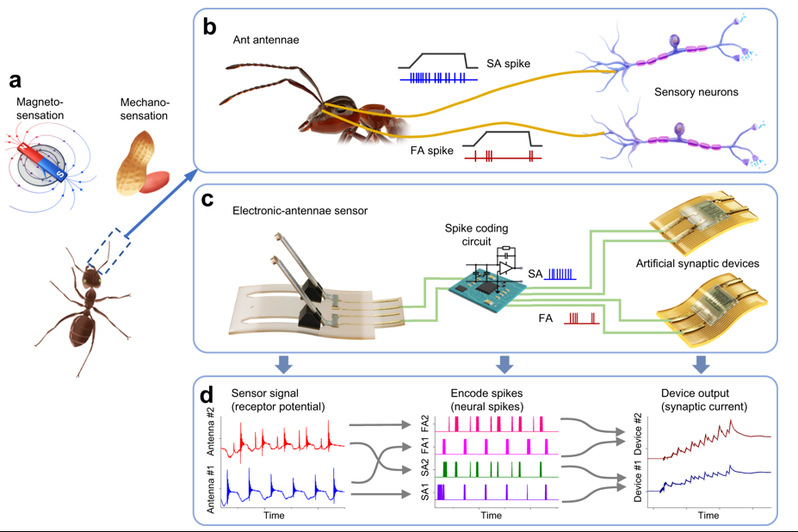NKU Team Develops Neuromorphic Artificial Antenna
The antennae are the primary sensory organs of insects, and can accurately perceive slight vibrations, magnetic field orientation, direction of gravity and chemical stimuli. Their perceptual sensitivity is comparable to that of human skin, and even outshine humans when it comes to some special functions. However, compared with mimicking the sensory organs of mammals, an urgent pending problem in the field of bionic electronics is how to simulate insect antenna – a highly sensitive and multi-functional “detector”. The structure and functions of insect antennal sensory organs offer a blueprint for the development of new biomimetic sensing systems. Inspired by this, the team led by Professor Xu Wentao from Nankai University developed a neuromorphic artificial antennal system, which realizes the tactile perception and magnetic field perception functions similar to the afferent nerves of ant antennae.
Recently, the paper introducing the results was published in Nature Communications, a world-renowned academic journal. Jiang Chengpeng, a postdoctoral fellow from the College of Electronic Information and Optical Engineering of Nankai University, is the first author, and Xu Wentao, a professor at the College of Electronic Information and Optical Engineering, and Kuniharu Takei, a professor at Hokkaido University in Japan, are the corresponding authors.

Figure 1. (a) Tactile perception and magnetic field perception functions of ant antennae; (b) morphological structure and coding strategy of ant antennal nerves; (c-d) Hardware architecture and information flow diagram of a neuromorphic artificial antennal system.
The neuromorphic artificial antennal system mimics the morphological structure, coding strategies, and perceptual functions of the afferent nerves of ant antennae. The system adopts an electronic antennal sensor with a three-dimensional flexible structure to achieve highly sensitive detection of vibration, deformation and magnetic field, and employs a flexible artificial synaptic device with two-dimensional nanosheets to realize the neuro-like processing of sensing information. The sensor array and the synaptic device array are connected in a way that mimics the architecture of bioreceptors and sensory neurons. The coding mode of the sensing signal mimics the pulse coding strategy of the mechanicoreceptor. Finally, the spatiotemporal characteristics of the sensing signal are identified in the neuromorphic hardware.

Figure 2. (a) Schematic diagram of tactile perception by ant antennae; (b) Schematic diagram of tactile identification by a neuromorphic artificial antennal system; (c-e) results of chess contour recognition; (f-h) results of surface pattern recognition; (i-k) result of material texture recognition.
Experimental results show that this system is capable of processing sensing data with high efficiency and low power consumption, and also perceiving pressure, texture and magnetic field highly sensitively. This system, when installed on mobile robots or interactive devices, has demonstrated perception performance close to or beyond that of humans in tasks such as contour recognition, texture recognition, material classification, magnetic field navigation, and contactless interaction.
In this study, neuromorphic hardware and bionic sensors are used to mimic the perception principle of insect antennae’ afferent nerves as well as information processing mechanism, representing a milestone in the field of bionic perception. It is expected to enhance the human beings’ ability to perceive and interact with the world, and it is of great significance for the development of advanced robots, augmented reality, intelligent interaction, flexible electronics and other fields.
Going forward, the research team plans to integrate soft actuators with neuromorphic artificial antennal systems to achieve perceptual-motor integration and active tactile exploration.
In recent years, the team led by Xu Wentao has focused on the field of flexible neuromorphic electronics, and has conducted systematic research on the design and development of artificial afferent (sensing) and efferent (motor) nerves, new principles of neuromorphic devices and groundbreaking performance, the preparation of neuromorphic fiber materials, among others. He has published over 70 papers in journals such as Science (1 paper), Nature Communications (6 papers), and Advanced Materials (2 papers) as a corresponding author or first author after returning to China in 2017.
URL:
https://www.nature.com/articles/s41467-024-46393-7
(Edited and translated by Nankai News Team.)









